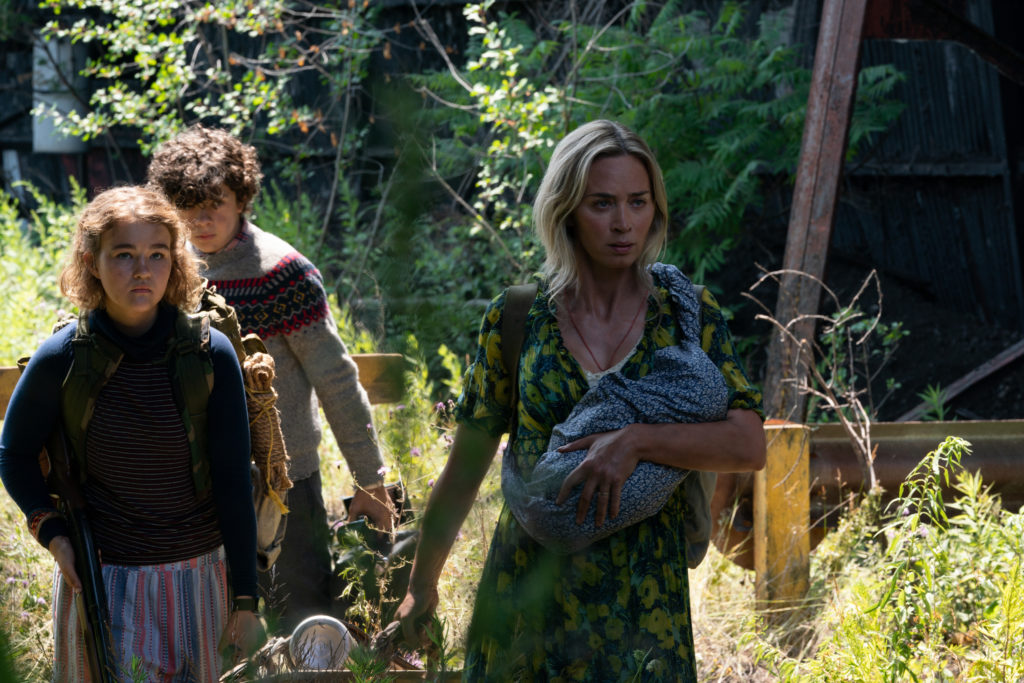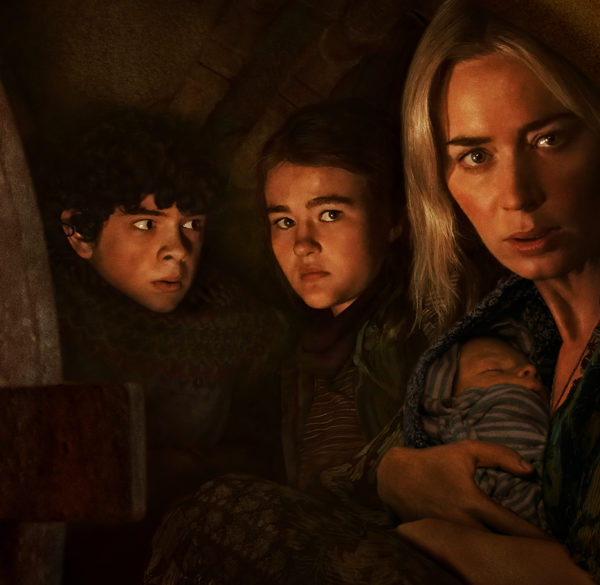Behind Simon and Garfunkel, the second-most famous duo associated with “the sound of silence” may be Erik Aadahl and Ethan Van der Ryn. The sound editors sculpted the auditory environment of 2018’s breakout horror-drama A Quiet Place, about a family of four attempting to silently survive a world overrun by blind predatory creatures possessing an acute sense of hearing. The pair earned an Academy Award nomination for Sound Editing for their work.
The duo returns for director John Krasinski’s sequel A Quiet Place Part II, in theaters May 28 from Paramount. The phone interview got off to an appropriate start, with their voices barely audible on the line due to a weak cell phone connection. After they called back a minute later on a landline, Van der Ryn quipped: “We were in a quiet place.”
A Quiet Place, more than perhaps any other film in recent memory, had an almost self-enforced silence in the theater. Moviegoers weren’t even opening their soda bottles. Did you keep that in mind when doing the sound design?
Ethan Van der Ryn: It was a question in our minds the whole time, when we were mixing and designing the sound during the original: Would people be able to stay quiet enough for the film to actually work? If people are making too much sound, they’re going to obliterate the story and the experience, which requires people to be completely silent. It was an experiment, in a way, whether or not that could work. Fortunately, it did.
Erik Aadahl: Our goal was really to make the audience an active participant in the movie, putting the audience in the shoes of the character. When Emily Blunt’s character Evelyn is holding her breath, trying not to make a noise, ideally we’d have the audience do the exact same thing. We didn’t really know if the whole thing would work until we premiered it at South by Southwest. A packed auditorium and the audience just went with it. They were holding their breath until the very end. It was such a vindication for this crazy experiment.
What was similar or different about working on the sequel, versus the original?
Van der Ryn: In the first one, we were setting up this whole universe where creatures have taken control of the earth. Humanity has had to adapt to be able to survive, by staying silent. We worked on creating and setting up all the rules of this whole universe. Obviously, with this one, because it’s a direct continuation of the story, we have this established set of rules in which to start playing. We don’t have to start from the ground up, to create the universe. It’s been creating, so we can just take off from there.
Aadahl: The last film was so successful, we feel like we caught lightning in a bottle. So the challenge is: How do we top it? How do we take it even further? Not just repeat ourselves, but create a new experience that’s going to be even more effective. That was the challenge for everybody involved with the film, not just for us in sound design, but [director] John [Krasinski] and the incredible cast.
So how did you try to top it?
Aadahl: If the first film was more intimate, this film definitely expands beyond the borders of the farm and the homestead. We’re exploring the world a little bit more. [The first trailer released opens with the family speeding down a street as dozens run in panic down the sidewalks, already showing more people in one scene than the first film did in total.] The first film opens a certain time after the invasion, but in this [film] we get a glimpse of day one. That was pretty fun to work on. Our challenge as a sound designer is, how do we expand upon the vocabulary and behavior of these creatures, go deeper with it? There were a lot more moments where we could play with that tension.

What was the hardest individual sound to create?
Van der Ryn: With the first film, we had to invent the creature sounds from scratch — something nobody had ever heard before, reverse engineering their biology. Knowing that they use sound to navigate the world, that they’re blind, we developed their palette of sound based on other living creatures that have a similar use of sound to navigate the world. For example, animals with echolocation or sonar. It was quite an experiment, going through and trying things, playing with sounds of dolphins and whales and bats. All of them use a similar clicking to reflect objects in their environment, so through sound they can paint a three-dimensional map. Eventually, we stumbled upon a stun gun, which had this really creepy alien feel. It was an electric taser, essentially, that became the spine of our echolocation sound.
Van der Ryn: We were playing around with this stun gun, trying to use it on different props that we had laying around our studio. There were some grapes sitting on a table in the kitchen. We tried it against the grapes and got the best sound. Grapes have a thin skin and fleshy interior, similar to humans. So that ended up being what we used. We just stumbled into that by accident. That’s why this is a great job! Play is required.
What’s the strangest thing you’ve ever done to create a sound in a movie?
Aadahl: I was working with Ethan on the first Transformers. We’d had a late night and I pulled into my driveway at home. I stepped out of the car and a garden hose was lying out. I stepped on it in such a way that the liquid in the hose made a gurgly sound. It almost sounded like a creature. I grabbed the garden hose, pulled it inside into the bathtub, started recording it, and those became the splatty vocals for Bumblebee in all the Transformers movies. If your ears are open, magic can happen.
How did the sound team work with Marco Beltrami on the score? [Beltrami, who also scored the first film, is a two-time Academy Award nominee for The Hurt Locker and 3:10 to Yuma.]
Van der Ryn: We love working with Marco. He just has such a big-picture, holistic sense of the film. He’s very gracious with not just where to play music, but where not to play music, so we can get really really quiet, make the audience lean in and hold their breath. He’s doing a gorgeous job expanding on the musical themes of the first film.
There’s a beautiful scene in the first film where Lee and Evelyn slow dance to the song Harvest Moon by Neil Young, listening through earbuds so they won’t attract the creatures. Whose decision was that? Yours, the music supervisor’s, Krasinski’s?
Van der Ryn: That’s John Krasinski, all the way. He wrote that into the script, specifically to be that song. He talked about it a little bit with us. The song was expensive, but it was important to him that it be that song specifically. It was worth securing the rights to use it and paying the money. For a lower budget film to spend that kind of money on one song was obviously a pretty big deal.
Aadahl: That song has special significance for him and his wife Emily. That’s a scene that’s based on their real-life relationship.
Between the two of you, you’ve won or been nominated for multiple awards, including the Oscars. [The pair has been nominated jointly for Transformers: Dark of the Moon, Argo, and the first A Quiet Place]. What’s your best awards show story?
Van der Ryn: My favorite awards experience was at the BAFTA Awards [in Britain]. I took my mom. As we were walking to the ball afterwards, all the photographers there started calling out, “Dame Judi! Dame Judi!” They thought my mom was Dame Judi Dench. So she started posing!
Aadahl: Before the Oscars, there’s the nominees’ luncheon. As my date, I brought my godmother. She lives in Washington state, she has nothing to do with Hollywood. We were standing next to Glenn Close, who’s her favorite actress of all time. She was just freaking out on me. “Can I take a picture?” It was fun to experience it through her eyes.
Why is it important to see A Quiet Place Part II in a cinema?
Van der Ryn: One of the unique things we experienced with the first A Quiet Place was that it really brought back the idea of cinema-going as a communal experience. It became such an interactive experience, where audiences were required to be completely silent in order for the movie to work. Hundreds of people were gathered together in this temple of cinema, being hushed, not talking. That’s such a special experience to have in this age of streaming.
Aadahl: We got a lot of feedback after the first film, people mentioning that after they saw it in a theater, after the end credits they heard the world in a completely new way. The sounds of traffic, the city. They were almost overwhelmed with the reality of sound in the world, after having gone through this experience of A Quiet Place. I think it would be a very different experience to watch it on Blu-ray in your home, when there might be a washing machine going.
"sound" - Google News
May 25, 2021 at 08:01PM
https://ift.tt/34dMFf0
The Sound of Silence: A Quiet Place Part II Sound Editors Speak Up - Boxoffice - Boxoffice Pro
"sound" - Google News
https://ift.tt/2MmdHZm
Shoes Man Tutorial
Pos News Update
Meme Update
Korean Entertainment News
Japan News Update


No comments:
Post a Comment